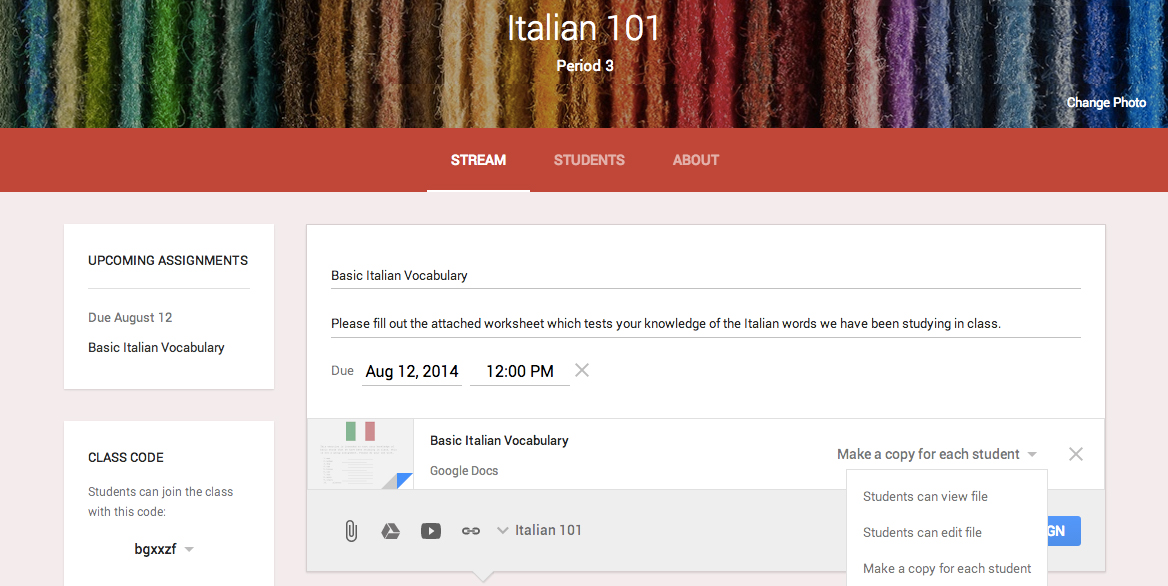Even Google needs feedback.
Today Google is officially opening the doors to Classroom, a tool that allows educators to create, organize and manage online assignments using Google Docs and Drive.
Sound familiar? The key word is “officially”--Google first let word out that it was inviting teachers to apply to be beta users of Classroom on May 5, neatly timed with Teacher Appreciation Day. More than 100,000 educators across 45 countries requested an invite.
And from the “tens of thousands” of teachers who piloted Google’s beta, Google got plenty of comments--and yes, tweaked the product, says Zach Yeskel, a product manager on Google’s Apps for Education team. The two most popular requests from teachers, Yeskel reports, were allowing teachers to view student assignments in progress, and a course overview page.
With these features added, Google is making Classroom publicly available in 42 languages. Anyone with a Google Apps for Education account can get started.
How Classroom Works
After creating a Class page and adding the student roster, teachers can immediately create assignments. One neat feature during this process is the automated copying of templates. Say a teacher wants to assign a book report and has a template created in Google Docs. Upon assigning it to the class, Classroom will automatically create copies of the document, with each student’s name appended to the name of the file. Every assignment will also be stored in its own folder.

Teachers can see students’ progress live on a dashboard and view (but not edit) the document. After the student has submitted the assignment, teachers can assign a grade out of 100 possible points. (Yeskel says requests for other grading rubrics will be considered in the future.)
Not having to deal with paper (and that infamous homework-eating dog) was a time saver to Classroom’s beta users, who reveled at being able to grade work as soon as it was ready. “If a student handed in an assignment early, I could grade and give feedback as they finish. It actually took the ‘man, my grading pile is so overwhelming’ feeling away,” praises Heidi Bernasconi, a biology teacher at Clarkstown Central High School North in New York.
Classroom isn’t limited to the classroom, either: Mary Ann Spicijaric, Principal of Fontbonne Hall Academy in New York, says she and her staff use it to prepare for department meetings. “We set up a Classroom consisting of Department Chairs so we can share the agenda and get comments before the meeting,” she shares.
Classroom currently does not integrate with any other apps, despite “a lot of conversation with developers interested in building on top of Classroom,” says Yeskel. Since addressing concerns over mining student information, the company promises to be more cautious. “Because we’re dealing with sensitive data, we’re going to be very deliberate how it gets passed and shared.”
This means that popular requests to sync assignment grades given on Classroom with schools’ online, third-party gradebooks and student information systems may have to wait. (Teachers can currently export the grades as an Excel file.) Another wish, raised by both Spicijaric and Bernasconi, is to be able to sync assignment due dates with students’ Google Calendar.
Joining the Fray
With over 30 million Google Apps for Education users, Google clearly has big ambitions in the education market and will compete with both established companies and startups.
Classroom is hardly the first--or only--tool for managing school assignments; learning management systems like Moodle and Blackboard offer this functionality. Bernasconi says she previously used Doctopus to organize online homework. Hapara’s initial product looked very similar to Classroom, but has since expanded its offerings. (Jack West, Lead Educator at Hapara, outlines the differences between Classroom and his company.)
The search giant’s move in education will certainly have the attention of the industry. In addition to Classroom, the company sees schools as a major target for another line of product: Chromebooks. A recent Gartner report estimates that education sales made up 85% of the estimated 2.4 million Chromebooks (or a tad over 2 million) sold in North America in 2013.
Perhaps Google will be that rare example of the big company with the right combination of resources and customer goodwill that can “disrupt” startups.



